Ann Lethbridge's Blog, page 26
March 26, 2012
More Tin Mining in Regency Cornwall
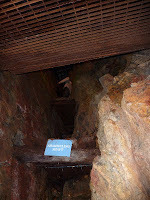 Now we have the technical details, or at least all we need, let us do a little exploring.
Now we have the technical details, or at least all we need, let us do a little exploring.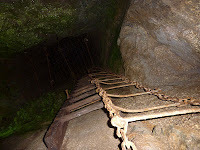
The first thing we came across was a shammeling shaft. If you look closely, you will see the figure of a man (waxwork) eight foot up inside this shaft. This was as high as a man standing below him could throw a shovel full of ore, so he could throw it up another eight feet. Backbreaking work, and think of all the rubble falling back down on the person at the bottom. They would do this all day long, too. Having climbed down into the depths of the mine down a shaft like this one.
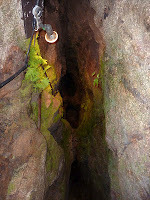
Here we saw how they would follow a narrowing load in hopes of finding a another wider section. You can imagine working in such a narrow space.
Also they left parts of the lode in tact, joining one side to the other to stabilize the walls,you can just make out one of those bridges in this picture.
In addition to being hand shoveled up from one level to another, there was also a system of iron buckets called kibbles being pulled up by horses hauling on rope around a wooden drum at the the surface. This is called a horse whim.
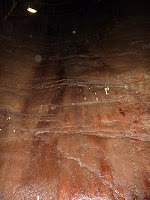
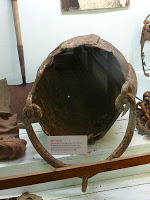
To the left is an example of a kibble. It doesn't seem to hold all much, but remember how heavy that ore was and a man had to lift it into order to get it onto the horse whim.
To the right is the evidence of years of mining. A granite wall worn smooth by all the kibble dragging up this shaft to the surface.
Taking photographs underground turned out not to be the most successful of operations, but there are a few more sights and sounds (yes, a bit of atmostphere) I want to share with you. Since blogger is slow on the picture posting, I am going to get back to writing now, and will leave a few more pictures and words for next time.
Until then, Happy Rambles
Published on March 26, 2012 06:04
March 21, 2012
More Tin Mining in Regency Cornwall
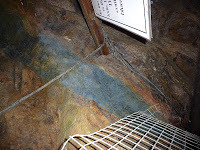
Last time we talked about how tin mining started on the surface, in streams. The people who undertook this kind of mining were called streamers. And streamers were still around in the Regency. But most of the really profitable mining by this time was underground.
The mine we visited was originally known as Wheal Roots. Wheal is the Cornish word for mine. If you want to know what Cornish sounds like and learn some words you can find several links on the web. This is one. http://www.bbc.co.uk/cornwall/connect...
The picture above shows what is called Blue Peach. Veins like this formed the Wheal Roots Lode, the source of tin and therefore the place to start digging. This lode was found on the surface and followed into the hillside.
The tin bearing ore had to be dug out, crushed then smelted into ingots. While waiting to go down the mine, I was handed a lump of tin ore. It was amazingly heavy for its size.
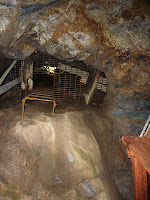
To get down into the mine in regency times and before, miners would climb down a ladder like the one shown in the shaft on the left. Only their ladder would have been made of wood and rope. You can just see daylight at the top and this was only a small part of the distance they would travel down into the ground. In the winter, they would go down before it got light and not go back up until after dark, day after day.
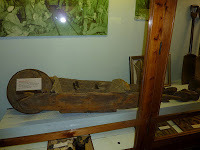 Both men and boys worked down the mine. The small wooden barrow on the right would have been used by a lad. The men were called to work from their homes by means of a bell and signaled that the shift was up by that same bell. The bell also was rung to summon help when there was an accident. And given that they were using black powder to move rocks it was likely to be a dreaded sound.
Both men and boys worked down the mine. The small wooden barrow on the right would have been used by a lad. The men were called to work from their homes by means of a bell and signaled that the shift was up by that same bell. The bell also was rung to summon help when there was an accident. And given that they were using black powder to move rocks it was likely to be a dreaded sound.Lots more to come. Until next time, Happy Rambles.
Published on March 21, 2012 22:00
March 18, 2012
Tin Mining in Cornwall
Do you remember the series Poldark? About tin mining families, set during the late Georgian period. Well it just so happens that the book I am working on now is set in Cornwall. And while my family is aristocratic, they own a tin mine. Mining in Cornwall had its hey day during the Regency. Copper became the most sought after and most profitable metal.
So last summer when I had the chance to go to Cornwall, I found a way to get myself down a tin mine. And guess what, it is call Poldark. It wasn't originally called that. I think they thought it would make for a good tourist attraction. The day we went it wasn't exactly teaming with people. Which was nice for us because that meant I could linger.
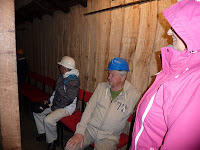 Here is our party, all ready to go down. Don't look too excited folks! I know it wasn't how you wanted to spend your vacation but....
Here is our party, all ready to go down. Don't look too excited folks! I know it wasn't how you wanted to spend your vacation but....
While it was the middle of summer, it was quite a damp rainy day. But that wasn't why we were all done up in our rain coats. You will see why later. Helmets were required. And I for one was glad of mine. Hah, no pun intended.
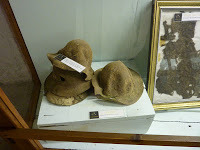 Miners wore felt hats in those days, like these pictured here that were discarded and later found in the old workings. The hats were dipped in pine resin to make them hard and stiff like a helmet. And because they were uncomfortable, miners would wear a cotton skull cap beneath them. This practice continued into the modern day with some miners wearing the skull caps beneath the kind of hard hard hats we wore.
Miners wore felt hats in those days, like these pictured here that were discarded and later found in the old workings. The hats were dipped in pine resin to make them hard and stiff like a helmet. And because they were uncomfortable, miners would wear a cotton skull cap beneath them. This practice continued into the modern day with some miners wearing the skull caps beneath the kind of hard hard hats we wore.
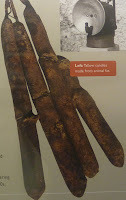 There was no electricity in those days, as you know, so a miner would light a candle made of tallow, or animal fat, drip the wax (tallow) onto the front of his hardened hat and stick the base of the candle into the hot wax. And there you have it, your own personal hands free light on your head.They also used lumps of hard clay to hold their candles.
There was no electricity in those days, as you know, so a miner would light a candle made of tallow, or animal fat, drip the wax (tallow) onto the front of his hardened hat and stick the base of the candle into the hot wax. And there you have it, your own personal hands free light on your head.They also used lumps of hard clay to hold their candles.
They would carry the candles in bunches, lik the ones you see pictured on the left, handing them around their necks. My guess is that they didn't last all that long, so you'd need a few for your day's work. They also attached them to ladders and the handles of their tools so they could light an area or the spot where they were working.
It was around this time that Davey was inventing the safety lamp, but one can imagine that those would be a luxury, and take a long time to to catch on. Indeed, one of the bunches of candles on display at the mine dated from the 1850's, so they continued to be used until around the time the mines became unprofitable.
Before we enter the mine itself, it behooves us to learn a bit about the ore and the history of this form of mining in Cornwall and its importance to the local people and mine owners.
Tin mining in Cornwall goes back to prehistoric times. The first mining, as has been discovered with regard to many other forms of precious minerals, was not mining but simply a scooping up from the surface, or from streams when ore bearing rocks had been exposed by the natural erosion of the land. The richest deposits of alluvial tin deposits were locted on Bodmin Moor, the moors around St Austell and Pokellis Moor near Wendron.
The earliest known artifacts from these surface workings date to 3,800 years ago. Tin works were worked by family groups or groups of tiners who roamed anyone's land looking for their bounty and only had to pay the land owner a fifteenth of their profit, or the "Lord's Dish" from the ore they found.
Tin mining was so important that in King John's time they were given their own Stannery Parliament, which set rules for taxation and excepted tin miners from military service. In 1337 when Edward III created the Duchy of Cornwall, it was confirmed that the tin miners were exempt from all civil jurisdiction other than that of the Stannary Courts, except in cases affecting land, life or limb. A rebellion in Henry the eighths time put this at risk,k but a payment of one thousand pounds to aid the war against Scotland put things to right again. This whole topic is extraordinarily interesting, but we have to move on to mining I'm afraid. So next time, early tin mining and then on to our visit below ground.
So last summer when I had the chance to go to Cornwall, I found a way to get myself down a tin mine. And guess what, it is call Poldark. It wasn't originally called that. I think they thought it would make for a good tourist attraction. The day we went it wasn't exactly teaming with people. Which was nice for us because that meant I could linger.
 Here is our party, all ready to go down. Don't look too excited folks! I know it wasn't how you wanted to spend your vacation but....
Here is our party, all ready to go down. Don't look too excited folks! I know it wasn't how you wanted to spend your vacation but....While it was the middle of summer, it was quite a damp rainy day. But that wasn't why we were all done up in our rain coats. You will see why later. Helmets were required. And I for one was glad of mine. Hah, no pun intended.
 Miners wore felt hats in those days, like these pictured here that were discarded and later found in the old workings. The hats were dipped in pine resin to make them hard and stiff like a helmet. And because they were uncomfortable, miners would wear a cotton skull cap beneath them. This practice continued into the modern day with some miners wearing the skull caps beneath the kind of hard hard hats we wore.
Miners wore felt hats in those days, like these pictured here that were discarded and later found in the old workings. The hats were dipped in pine resin to make them hard and stiff like a helmet. And because they were uncomfortable, miners would wear a cotton skull cap beneath them. This practice continued into the modern day with some miners wearing the skull caps beneath the kind of hard hard hats we wore. There was no electricity in those days, as you know, so a miner would light a candle made of tallow, or animal fat, drip the wax (tallow) onto the front of his hardened hat and stick the base of the candle into the hot wax. And there you have it, your own personal hands free light on your head.They also used lumps of hard clay to hold their candles.
There was no electricity in those days, as you know, so a miner would light a candle made of tallow, or animal fat, drip the wax (tallow) onto the front of his hardened hat and stick the base of the candle into the hot wax. And there you have it, your own personal hands free light on your head.They also used lumps of hard clay to hold their candles.They would carry the candles in bunches, lik the ones you see pictured on the left, handing them around their necks. My guess is that they didn't last all that long, so you'd need a few for your day's work. They also attached them to ladders and the handles of their tools so they could light an area or the spot where they were working.
It was around this time that Davey was inventing the safety lamp, but one can imagine that those would be a luxury, and take a long time to to catch on. Indeed, one of the bunches of candles on display at the mine dated from the 1850's, so they continued to be used until around the time the mines became unprofitable.
Before we enter the mine itself, it behooves us to learn a bit about the ore and the history of this form of mining in Cornwall and its importance to the local people and mine owners.
Tin mining in Cornwall goes back to prehistoric times. The first mining, as has been discovered with regard to many other forms of precious minerals, was not mining but simply a scooping up from the surface, or from streams when ore bearing rocks had been exposed by the natural erosion of the land. The richest deposits of alluvial tin deposits were locted on Bodmin Moor, the moors around St Austell and Pokellis Moor near Wendron.
The earliest known artifacts from these surface workings date to 3,800 years ago. Tin works were worked by family groups or groups of tiners who roamed anyone's land looking for their bounty and only had to pay the land owner a fifteenth of their profit, or the "Lord's Dish" from the ore they found.
Tin mining was so important that in King John's time they were given their own Stannery Parliament, which set rules for taxation and excepted tin miners from military service. In 1337 when Edward III created the Duchy of Cornwall, it was confirmed that the tin miners were exempt from all civil jurisdiction other than that of the Stannary Courts, except in cases affecting land, life or limb. A rebellion in Henry the eighths time put this at risk,k but a payment of one thousand pounds to aid the war against Scotland put things to right again. This whole topic is extraordinarily interesting, but we have to move on to mining I'm afraid. So next time, early tin mining and then on to our visit below ground.
Published on March 18, 2012 23:00
March 2, 2012
Searching for Regency England
Wardour Castle (Continued)
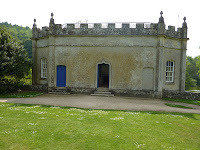
 In the 18th century, Wardour Castle became a romantic ruin to a new house for the Arundel's built across the lake also created in the 18th century during the landscaping of the park. How romantic is that view.
In the 18th century, Wardour Castle became a romantic ruin to a new house for the Arundel's built across the lake also created in the 18th century during the landscaping of the park. How romantic is that view.
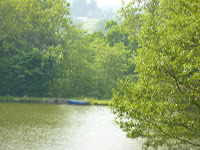
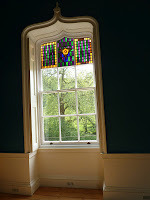 The small building to the left overlooks that lake and was built as a summer picknic pavilion. Quite honestly I was surprised to see that the pavilion looks back across that lake rather than at the ruin itself. Built in the gothic stylepopular in the 1770's, I thought the windows rather small. By the 1830's this summer house had become a public refreshment room and dining room. These days it is used for weddings and such.
The small building to the left overlooks that lake and was built as a summer picknic pavilion. Quite honestly I was surprised to see that the pavilion looks back across that lake rather than at the ruin itself. Built in the gothic stylepopular in the 1770's, I thought the windows rather small. By the 1830's this summer house had become a public refreshment room and dining room. These days it is used for weddings and such.
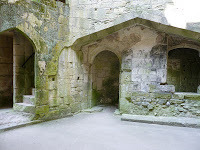
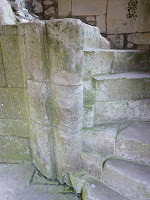 I took many many pictures inside the castle, none of which are relevant to our topic, all about that medieval I will write one day I suppose, or the fantasy playing out in the back of my mind. But since I am writing a Regency-set gothic, and I definitely have a thing for towers and circular staircases, and some of the feeling of these will show up in that work, no doubt.
I took many many pictures inside the castle, none of which are relevant to our topic, all about that medieval I will write one day I suppose, or the fantasy playing out in the back of my mind. But since I am writing a Regency-set gothic, and I definitely have a thing for towers and circular staircases, and some of the feeling of these will show up in that work, no doubt.
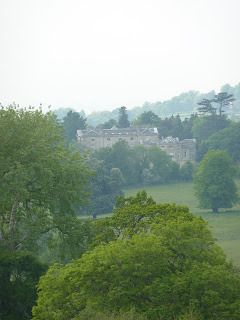
Our last picture is a view of the house built to replace the castle during the late 1700's. So we are really in the garden looking back at the house. It is not open to the public.
Until next time, happy rambles.


 In the 18th century, Wardour Castle became a romantic ruin to a new house for the Arundel's built across the lake also created in the 18th century during the landscaping of the park. How romantic is that view.
In the 18th century, Wardour Castle became a romantic ruin to a new house for the Arundel's built across the lake also created in the 18th century during the landscaping of the park. How romantic is that view.
 The small building to the left overlooks that lake and was built as a summer picknic pavilion. Quite honestly I was surprised to see that the pavilion looks back across that lake rather than at the ruin itself. Built in the gothic stylepopular in the 1770's, I thought the windows rather small. By the 1830's this summer house had become a public refreshment room and dining room. These days it is used for weddings and such.
The small building to the left overlooks that lake and was built as a summer picknic pavilion. Quite honestly I was surprised to see that the pavilion looks back across that lake rather than at the ruin itself. Built in the gothic stylepopular in the 1770's, I thought the windows rather small. By the 1830's this summer house had become a public refreshment room and dining room. These days it is used for weddings and such.
 I took many many pictures inside the castle, none of which are relevant to our topic, all about that medieval I will write one day I suppose, or the fantasy playing out in the back of my mind. But since I am writing a Regency-set gothic, and I definitely have a thing for towers and circular staircases, and some of the feeling of these will show up in that work, no doubt.
I took many many pictures inside the castle, none of which are relevant to our topic, all about that medieval I will write one day I suppose, or the fantasy playing out in the back of my mind. But since I am writing a Regency-set gothic, and I definitely have a thing for towers and circular staircases, and some of the feeling of these will show up in that work, no doubt.
Our last picture is a view of the house built to replace the castle during the late 1700's. So we are really in the garden looking back at the house. It is not open to the public.
Until next time, happy rambles.
Published on March 02, 2012 06:34
February 26, 2012
Posting a Letter in the Regency
 It was too soon for Mary to send Sally a letter, too much to ask her to pay for so little news.
It was too soon for Mary to send Sally a letter, too much to ask her to pay for so little news. I wrote this today in my current work in progress. But was I right? I thought I had it right, but really, what do I know about sending a letter in Regency England.
After hitting the my own files and some of the sites, I discovered more than I ever wanted to know. Here are a few things I thought you might find of interest.
First of all, I was right about the receiver of the letter having to pay the cost of mailing. In this case from St Ives in Cornwall to somewhere near Old Sarum in Wiltshire.
All letters went via London. So in this case, the letter would pass Old Sarum, then be sent back there. Letters were charged according to distance and and the number of sheets of paper:
Within Great Britain:-
Not exceeding 15 miles 4d Above 15 but not more than 20 miles 5d Above 20 but not more than 30 miles 6d Above 30 but not more than 50 miles 7d Above 50 but not more than 80 miles 8d Above 80 but not more than 120 miles 9d Above 120 but not more than 170 miles 10d Above 170 but not more than 230 miles 11d Above 230 but not more than 300 miles 12d Above 300 but not more than 400 miles 13d Above 400 but not more than 500 miles 14d Above 500 but not more than 600 miles 15d Above 600 but not more than 700 miles 16d Above 700 miles 17d
For example, a typical single page letter from Dublin to London would cost 1s 3d - a lot of money in those days, when you consider that a Dairy maid 6 pence per day, less than half this amount. Can you imagine sending a letter at the cost of a whole days pay? Two sheets of paper doubled the cost, three tripled it. And paper was not a cheap commodity either.
This high cost is partly because you paid twice. Once to get the letter to London, and again to get it to its destination. And sometimes cities added their own charges for delivery also, usually a penny. And this is why, out of respect, the sender would keep their information to a single page and only write if needed. To save paper they would "cross their lines" turn the paper at right angles and write in that direction as shown in the picture. In most places one had to go the the post office to collect one's mail rather than it being delivered to the door. Which is apparently something we are returning to these days.
By the way, there were no envelopes in the Regency. The sheet of paper would contain the address on the outside, and be sealed with wax or a wafer. Additional sheets would be folded inside.
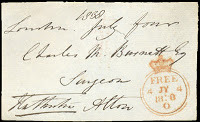 Not all mail had to be paid for. Letters from, Members of Parliament, Commons and Lords as well as newspapers travelled for free. It was intended for official business, but as we so often read in books, Peers etc were often asked to frank (sign and stamp the letter as official) letters for friends and relatives to save the high cost of postage . This example dates from 1930. The postal system was overhauled not long after this and the franking of letters was abolished in 1840.
Not all mail had to be paid for. Letters from, Members of Parliament, Commons and Lords as well as newspapers travelled for free. It was intended for official business, but as we so often read in books, Peers etc were often asked to frank (sign and stamp the letter as official) letters for friends and relatives to save the high cost of postage . This example dates from 1930. The postal system was overhauled not long after this and the franking of letters was abolished in 1840.If you want to dig deeper than I do at present, I would recommend starting with http://postalheritage.org.uk
No doubt there will be a new question on my mind requiring information in the not too distant future and until then, Happy Rambles
Published on February 26, 2012 22:00
February 22, 2012
Royal Weddings, family weddings and more
[image error]
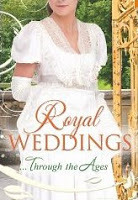 It came as quite a surprise when I discovered that the story I did for the Royal Wedding last April, is now coming out with the other stories as a print anthology in the UK. It's a bit like getting the wedding cake out of the freezer on the first anniversary, I suppose.
It came as quite a surprise when I discovered that the story I did for the Royal Wedding last April, is now coming out with the other stories as a print anthology in the UK. It's a bit like getting the wedding cake out of the freezer on the first anniversary, I suppose.
For those of you in North America, I know you will be hugely disappointed to learn that this print version is only available in the UK. Sigh. Oh but wait! You can order it from The Book Depository, no shipping charged for delivery. Yay!
What do you think of the new cover, as against the generic one for the e-book? Just a bit tasty don't you think?
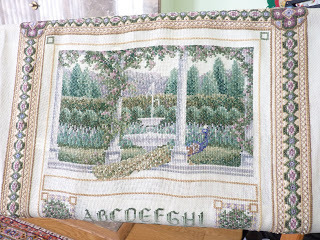
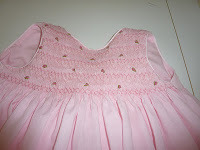 So back before Christmas I said I would publicly track my progress on this cross-stitch project as a way of motivating me to get it done! This is the photo I took at the end of January. Now if you look very very carefully, and compare to the last picture (as if you would) you will see that the outside border is finished, beads and all. And I have rolled it upwards a fraction to start on the embellishment to the fountain scene.
So back before Christmas I said I would publicly track my progress on this cross-stitch project as a way of motivating me to get it done! This is the photo I took at the end of January. Now if you look very very carefully, and compare to the last picture (as if you would) you will see that the outside border is finished, beads and all. And I have rolled it upwards a fraction to start on the embellishment to the fountain scene.
 I have been working away during February on that scene and will post another picture at the end of the month. And just to brag a wee bit, I also made the dress. I love the smocking part, but have to force myself to construct the garment. This one with its lack of sleeves went together very well.
I have been working away during February on that scene and will post another picture at the end of the month. And just to brag a wee bit, I also made the dress. I love the smocking part, but have to force myself to construct the garment. This one with its lack of sleeves went together very well.
I just returned from a delightful family wedding in Trinidad, hence the lack of posts, accompanied by a bit of fun in the sun on the Island of Tobago. While the weather was a bit on the damp side, it was lovely to meet up with old friends and catch up on all the family gossip.
In true Royal Wedding tradition, I wore my fascinator. Felt like a Princess for a day.
There you have it, what I have been up to since you saw me last. Next we return to our regular programming. Until then, Happy Rambles.
 It came as quite a surprise when I discovered that the story I did for the Royal Wedding last April, is now coming out with the other stories as a print anthology in the UK. It's a bit like getting the wedding cake out of the freezer on the first anniversary, I suppose.
It came as quite a surprise when I discovered that the story I did for the Royal Wedding last April, is now coming out with the other stories as a print anthology in the UK. It's a bit like getting the wedding cake out of the freezer on the first anniversary, I suppose. For those of you in North America, I know you will be hugely disappointed to learn that this print version is only available in the UK. Sigh. Oh but wait! You can order it from The Book Depository, no shipping charged for delivery. Yay!
What do you think of the new cover, as against the generic one for the e-book? Just a bit tasty don't you think?

 So back before Christmas I said I would publicly track my progress on this cross-stitch project as a way of motivating me to get it done! This is the photo I took at the end of January. Now if you look very very carefully, and compare to the last picture (as if you would) you will see that the outside border is finished, beads and all. And I have rolled it upwards a fraction to start on the embellishment to the fountain scene.
So back before Christmas I said I would publicly track my progress on this cross-stitch project as a way of motivating me to get it done! This is the photo I took at the end of January. Now if you look very very carefully, and compare to the last picture (as if you would) you will see that the outside border is finished, beads and all. And I have rolled it upwards a fraction to start on the embellishment to the fountain scene.  I have been working away during February on that scene and will post another picture at the end of the month. And just to brag a wee bit, I also made the dress. I love the smocking part, but have to force myself to construct the garment. This one with its lack of sleeves went together very well.
I have been working away during February on that scene and will post another picture at the end of the month. And just to brag a wee bit, I also made the dress. I love the smocking part, but have to force myself to construct the garment. This one with its lack of sleeves went together very well.I just returned from a delightful family wedding in Trinidad, hence the lack of posts, accompanied by a bit of fun in the sun on the Island of Tobago. While the weather was a bit on the damp side, it was lovely to meet up with old friends and catch up on all the family gossip.
In true Royal Wedding tradition, I wore my fascinator. Felt like a Princess for a day.
There you have it, what I have been up to since you saw me last. Next we return to our regular programming. Until then, Happy Rambles.
Published on February 22, 2012 22:08
February 6, 2012
Interview with a Rake
Here is where you pay for the research by letting me post about my book
Lady Rosabella`s Ruse
. Of course, you can quite easily skip the whole thing, so I don`t feel the slightest bit guilty.
[image error] None of the women at an "anything goes" house party catches Garth Evernden's jaded eye. The only one worth noting is a covered-up lady's companion with an intriguing hint of exotic beauty the eighth Baron Stanford would like to uncover…
Miss Lethbridge: Here we are readers, at this elegant country house not far from the Kent coast where a group of rather risque ladies and gentlemen have gathered for a week or two of "fun". At the moment, I am lying in wait for Lord Stanford, Garth Evernden, a well-known man about town. (Smiles sweetly at the tall dark gentlemen trying to avoid her.) Good morning Baron Stanford, isn`t it rather early for you to be up and about?
Lord Stanford: (Impatient sigh.) Excuse me. I am rather busy at the moment. Looking for someone.
Miss Lethbridge: (Sneaky smile. Oh goody, we are going to get some dirt. My editor will be pleased.) Really? And who would that be?
Lord Stanford: (dark eyebrow raised) Not the sort of thing I am in the habit of revealing, madame.
Miss Lethbridge: I thought you hated this sort of contrived "naughtiness" where people pretend to be wicked, Garth? May I call you Garth?
Garth: (a rather bored expression crosses his face) If you wish. If I am going to be honest, I wouldn't be here if it wasn't for a certain young lady. He looks around. She is the wife of a good friend of mine.
Miss Lethbridge: Isn't that rather disloyal? (I realize I am frowning at him and try to merely look interested. I realize by the flash of anger in his eyes I am not doing a very good job.) Er... so that is who you are looking for this morning?
Garth: That is who I was looking for when I arrived here yesterday. (His smile becomes rather wolfish and I take a step back) I don't think she was all that happy to see me.
Miss Lethbridge: That pleases you?
Garth: It's a place to start. At least I have her attention.
Miss Lethbridge: But if you are not looking for her this morning, who are you looking for?
Garth: Our hostess's companion, Rose. I caught her sneaking into the house last night. There is something going on with that young lady.
Miss Lethbridge: And that intrigues you, does it?
Garth: Look, despite that she is a funny old stick, I like Lady Keswick . If this companion of hers, Rose, is up to no good, I think she ought to be warned. And if she is up for night time assignations, then...well... Yes, I'm intrigued. Under those widows weeds is a flower that is both exotic and secretive. What is she hiding? .
Miss Lethbridge: So now you are in pursuit of two women?
Garth: (wicked grin). You didn't actually think I was going to give the plot away, did you?
I was hoping. He brushes past me and heads for the breakfast room, where uninvited reporters are not permitted. Blast. Perhaps I will get more information out of Mrs Rose Travenor. Perhaps I should hide in the garden and wait for her to appear. And if I learn anything, anything at all, you Dear Reader, will be the first to know. Tune in again next time. Until then, Happy Rambles
You, dear reader, can purchase Lady Rosabella's Ruse at all your favourite stores, either in person or on line. Here are a few links for various on line places from various places around the world if you would find them helpful. While you are it it you might want to look out for The Royal Weddings Anthology out in Print this month.

Find "Lady Rosabella's Ruse" At Barnes and Noble

Find "Lady Rosabella's Ruse" at Chapters in Canada
"Lady Rosabella's Ruse" at Mills and Boon
"Lady Rosabella's Ruse at Foyles" UK
Find "Lady Rosabella's Ruse" at Blackwell Books
Find "Lady Rosabella's Ruse" At Pickabook, UK

Find "Lady Rosabella's Ruse" on Amazon.com

Lady Rosabella's Ruse at Amazon.co.uk

[image error] None of the women at an "anything goes" house party catches Garth Evernden's jaded eye. The only one worth noting is a covered-up lady's companion with an intriguing hint of exotic beauty the eighth Baron Stanford would like to uncover…
Miss Lethbridge: Here we are readers, at this elegant country house not far from the Kent coast where a group of rather risque ladies and gentlemen have gathered for a week or two of "fun". At the moment, I am lying in wait for Lord Stanford, Garth Evernden, a well-known man about town. (Smiles sweetly at the tall dark gentlemen trying to avoid her.) Good morning Baron Stanford, isn`t it rather early for you to be up and about?
Lord Stanford: (Impatient sigh.) Excuse me. I am rather busy at the moment. Looking for someone.
Miss Lethbridge: (Sneaky smile. Oh goody, we are going to get some dirt. My editor will be pleased.) Really? And who would that be?
Lord Stanford: (dark eyebrow raised) Not the sort of thing I am in the habit of revealing, madame.
Miss Lethbridge: I thought you hated this sort of contrived "naughtiness" where people pretend to be wicked, Garth? May I call you Garth?
Garth: (a rather bored expression crosses his face) If you wish. If I am going to be honest, I wouldn't be here if it wasn't for a certain young lady. He looks around. She is the wife of a good friend of mine.
Miss Lethbridge: Isn't that rather disloyal? (I realize I am frowning at him and try to merely look interested. I realize by the flash of anger in his eyes I am not doing a very good job.) Er... so that is who you are looking for this morning?
Garth: That is who I was looking for when I arrived here yesterday. (His smile becomes rather wolfish and I take a step back) I don't think she was all that happy to see me.
Miss Lethbridge: That pleases you?
Garth: It's a place to start. At least I have her attention.
Miss Lethbridge: But if you are not looking for her this morning, who are you looking for?
Garth: Our hostess's companion, Rose. I caught her sneaking into the house last night. There is something going on with that young lady.
Miss Lethbridge: And that intrigues you, does it?
Garth: Look, despite that she is a funny old stick, I like Lady Keswick . If this companion of hers, Rose, is up to no good, I think she ought to be warned. And if she is up for night time assignations, then...well... Yes, I'm intrigued. Under those widows weeds is a flower that is both exotic and secretive. What is she hiding? .
Miss Lethbridge: So now you are in pursuit of two women?
Garth: (wicked grin). You didn't actually think I was going to give the plot away, did you?
I was hoping. He brushes past me and heads for the breakfast room, where uninvited reporters are not permitted. Blast. Perhaps I will get more information out of Mrs Rose Travenor. Perhaps I should hide in the garden and wait for her to appear. And if I learn anything, anything at all, you Dear Reader, will be the first to know. Tune in again next time. Until then, Happy Rambles
You, dear reader, can purchase Lady Rosabella's Ruse at all your favourite stores, either in person or on line. Here are a few links for various on line places from various places around the world if you would find them helpful. While you are it it you might want to look out for The Royal Weddings Anthology out in Print this month.

Find "Lady Rosabella's Ruse" At Barnes and Noble

Find "Lady Rosabella's Ruse" at Chapters in Canada

"Lady Rosabella's Ruse" at Mills and Boon
"Lady Rosabella's Ruse at Foyles" UK
Find "Lady Rosabella's Ruse" at Blackwell Books
Find "Lady Rosabella's Ruse" At Pickabook, UK

Find "Lady Rosabella's Ruse" on Amazon.com

Lady Rosabella's Ruse at Amazon.co.uk

Published on February 06, 2012 08:47
January 29, 2012
Searching for Regency England
All right, so I love castles. Don't forget that the castles scattering Great Britain today scattered them equally during the Regency. Our lords and ladies saw them then, just as we see them today. Well, perhaps not quite, because work to make them accessible has happened more recently. But they were there.
We found Wardour Castle an English Heritage site in Wilshire quite by chance when we were driving out to one of the great houses. Of course we could not resist taking a peek.
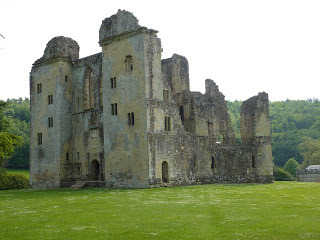 The castle was destroyed during the English civil war and although the Arundells managed to come through it all in the end, in the mid 1700's they built a new castle (really a palladian manor house) and the castle was left to grace the estate as a kind of folly.
The castle was destroyed during the English civil war and although the Arundells managed to come through it all in the end, in the mid 1700's they built a new castle (really a palladian manor house) and the castle was left to grace the estate as a kind of folly.
The old castle is unique in Britain, having been built as a six sided structure in the late 14th century, mimicking those the owner, Lord Lovell had seen in France. So you can see the actual shape of it, I am including an artists impression of how it looked when it was built.
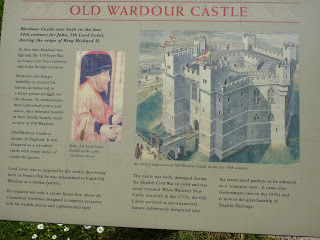 You will not doubt notice the little clump of daisies beneath the sign.
You will not doubt notice the little clump of daisies beneath the sign.
So my interest is in the castle as a ruin, since that is how it would have been for our Regency ladies and gentlemen visiting this part of the country, and who knows, perhaps they stayed with Lord Arundell. But if you like castles or earlier periods of history, no doubt you will also enjoy looking at the ruins.
Next time we will take a look around the castle and its grounds and a sneak peek at the New Cast5le.
Until next time, Happy Rambles
We found Wardour Castle an English Heritage site in Wilshire quite by chance when we were driving out to one of the great houses. Of course we could not resist taking a peek.
 The castle was destroyed during the English civil war and although the Arundells managed to come through it all in the end, in the mid 1700's they built a new castle (really a palladian manor house) and the castle was left to grace the estate as a kind of folly.
The castle was destroyed during the English civil war and although the Arundells managed to come through it all in the end, in the mid 1700's they built a new castle (really a palladian manor house) and the castle was left to grace the estate as a kind of folly.The old castle is unique in Britain, having been built as a six sided structure in the late 14th century, mimicking those the owner, Lord Lovell had seen in France. So you can see the actual shape of it, I am including an artists impression of how it looked when it was built.
 You will not doubt notice the little clump of daisies beneath the sign.
You will not doubt notice the little clump of daisies beneath the sign.So my interest is in the castle as a ruin, since that is how it would have been for our Regency ladies and gentlemen visiting this part of the country, and who knows, perhaps they stayed with Lord Arundell. But if you like castles or earlier periods of history, no doubt you will also enjoy looking at the ruins.
Next time we will take a look around the castle and its grounds and a sneak peek at the New Cast5le.
Until next time, Happy Rambles
Published on January 29, 2012 22:00
January 25, 2012
Regency Fashion
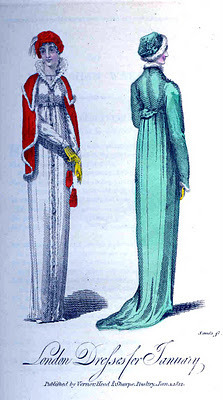 January 1812. We are still in the first year of the Regency and here is what the ladies were wearing in January.
January 1812. We are still in the first year of the Regency and here is what the ladies were wearing in January.Lady's Monthly Museum
Cabinet of Fashion
A plain muslin dress, made high to fit the bosom with a plaited ruff; the front of the dress confined with coral clasps; earrings and necklace to correspond. Hungarian mantle, with double capes, trimmed with white swansdown, and fixed at the throat with cord and tassels. A small eastern turban, the same colour as the mantle, with white feathers; buff gloves and shoes.
I really like the modesty of this first gown. It has an elegance about it that appeals to me. And the ruff is very Elizabethan/Tudor. Note the hairstyle. She is sporting one, which always appeals to me, the long tress or curl coming over one shoulder.
The second figure is:
A riding dress of fine Georgian cloth, of a green colour, ornamented with frogs militarie in front and finished at the pocket holes with the same. Hat of green velvet, trimmed with white fur. Buff boots and gloves.
Pocket holes, an interesting way to describe them. I always like the idea of military styled riding dresses for ladies, but this view shows the train to perfection. This would ensure the lady's legs are well covered once she is sideways on the horse. I don't know what Georgian cloth is, do you?
So here we see what the ladies were wearing as we approach the end of the first year of the Regency.
Until next time, Happy Rambles
Published on January 25, 2012 22:00
January 22, 2012
What did Happen During the Regency?
Continuing snippets of the news two hundred years ago to celebrate and 200th anniversary of the beginning of the Regency era.
1811
May 22: - several peoplewere killed by a house falling at Seven Dials.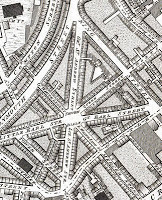 This was in one of the poorest and most notorious regions of London in the Parish of St Giles where one also found the worst of the rookeries. A dangerous place for any Regency buck or miss to wander at any time of the day, but even worse for those that lived there. Near to Covent Garden, it was called Seven Dials because of the way the streets and alleys come together in one intersection which originally had a sundial in the centre. The first plan in 1690 was for six streets, but the developer Thomas Neale who planned this to be a smart end of town with large fronted shops, added a seventh in the final plans in order to increase his income from rents. It never achieved its potential. After his death, the houses were subdivided and quickly became slums, renowned for gin shops. At times, the area threatened to descend into the undesirable depravity of the St Giles "Rookery" to the north, but it was predominantly a working neighbourhood, with woodcarvers, straw-hat manufacturers, pork butchers, watch repairers, booksellers, pubs and breweries.At one point each of the seven apexes facing the Monument housed a pub, their cellars and vaults connected in the basement providing handy escape routes should the need arise.These days it is very different. It has boutique style shops and a new sense of community. Over 25% of its buildings are "listed" (protected) and many date back to the 1690's. Clearly not the one that fell on these poor people.
This was in one of the poorest and most notorious regions of London in the Parish of St Giles where one also found the worst of the rookeries. A dangerous place for any Regency buck or miss to wander at any time of the day, but even worse for those that lived there. Near to Covent Garden, it was called Seven Dials because of the way the streets and alleys come together in one intersection which originally had a sundial in the centre. The first plan in 1690 was for six streets, but the developer Thomas Neale who planned this to be a smart end of town with large fronted shops, added a seventh in the final plans in order to increase his income from rents. It never achieved its potential. After his death, the houses were subdivided and quickly became slums, renowned for gin shops. At times, the area threatened to descend into the undesirable depravity of the St Giles "Rookery" to the north, but it was predominantly a working neighbourhood, with woodcarvers, straw-hat manufacturers, pork butchers, watch repairers, booksellers, pubs and breweries.At one point each of the seven apexes facing the Monument housed a pub, their cellars and vaults connected in the basement providing handy escape routes should the need arise.These days it is very different. It has boutique style shops and a new sense of community. Over 25% of its buildings are "listed" (protected) and many date back to the 1690's. Clearly not the one that fell on these poor people.
 June14: -The proceedings of the House of Commons state the number of French prisoners in England to be near 50,000.Aug. 21: - A comet made its appearance above the horizon. The Great Comet of 1811. It is estimated that this comet comes around once every three thousand plus years, so I won't be around to see it the next time. The drawing is by William Henry Smyth in 1811.Sep.11: - Discovery made at the Queen's house that her majesty's court dress had been stolen. Really, how bad is that?November unrest: -- Bands of men appear wearing masks and armed with muskets, pistols and hatchets and break into the small hosiery workshops scattered thoughout country villages. Hammermen carrying hung heavy iron sledgehammers smashed open the doors of the workshops and beat at the wide stocking frames until they are destroyed. E.g. Nov 4 6 frames broken at the village of Bulwell on November 4, a dozen at Kimberley a few nights later. November 13 70 frames smashed in a single attack at Sutton-in-Ashfield. Claimed allegiance to "General Ludd". Magistrates cannot police the rural jurisdictions. A military force, a squadron of dragoons, the Mansfield Volunteers, two troops of Yeomanry were ineffective.That is it for now, I hope you enjoyed this peek of life in the first year of the Regency. Until next time Happy Rambles.
June14: -The proceedings of the House of Commons state the number of French prisoners in England to be near 50,000.Aug. 21: - A comet made its appearance above the horizon. The Great Comet of 1811. It is estimated that this comet comes around once every three thousand plus years, so I won't be around to see it the next time. The drawing is by William Henry Smyth in 1811.Sep.11: - Discovery made at the Queen's house that her majesty's court dress had been stolen. Really, how bad is that?November unrest: -- Bands of men appear wearing masks and armed with muskets, pistols and hatchets and break into the small hosiery workshops scattered thoughout country villages. Hammermen carrying hung heavy iron sledgehammers smashed open the doors of the workshops and beat at the wide stocking frames until they are destroyed. E.g. Nov 4 6 frames broken at the village of Bulwell on November 4, a dozen at Kimberley a few nights later. November 13 70 frames smashed in a single attack at Sutton-in-Ashfield. Claimed allegiance to "General Ludd". Magistrates cannot police the rural jurisdictions. A military force, a squadron of dragoons, the Mansfield Volunteers, two troops of Yeomanry were ineffective.That is it for now, I hope you enjoyed this peek of life in the first year of the Regency. Until next time Happy Rambles.
1811
May 22: - several peoplewere killed by a house falling at Seven Dials.
 This was in one of the poorest and most notorious regions of London in the Parish of St Giles where one also found the worst of the rookeries. A dangerous place for any Regency buck or miss to wander at any time of the day, but even worse for those that lived there. Near to Covent Garden, it was called Seven Dials because of the way the streets and alleys come together in one intersection which originally had a sundial in the centre. The first plan in 1690 was for six streets, but the developer Thomas Neale who planned this to be a smart end of town with large fronted shops, added a seventh in the final plans in order to increase his income from rents. It never achieved its potential. After his death, the houses were subdivided and quickly became slums, renowned for gin shops. At times, the area threatened to descend into the undesirable depravity of the St Giles "Rookery" to the north, but it was predominantly a working neighbourhood, with woodcarvers, straw-hat manufacturers, pork butchers, watch repairers, booksellers, pubs and breweries.At one point each of the seven apexes facing the Monument housed a pub, their cellars and vaults connected in the basement providing handy escape routes should the need arise.These days it is very different. It has boutique style shops and a new sense of community. Over 25% of its buildings are "listed" (protected) and many date back to the 1690's. Clearly not the one that fell on these poor people.
This was in one of the poorest and most notorious regions of London in the Parish of St Giles where one also found the worst of the rookeries. A dangerous place for any Regency buck or miss to wander at any time of the day, but even worse for those that lived there. Near to Covent Garden, it was called Seven Dials because of the way the streets and alleys come together in one intersection which originally had a sundial in the centre. The first plan in 1690 was for six streets, but the developer Thomas Neale who planned this to be a smart end of town with large fronted shops, added a seventh in the final plans in order to increase his income from rents. It never achieved its potential. After his death, the houses were subdivided and quickly became slums, renowned for gin shops. At times, the area threatened to descend into the undesirable depravity of the St Giles "Rookery" to the north, but it was predominantly a working neighbourhood, with woodcarvers, straw-hat manufacturers, pork butchers, watch repairers, booksellers, pubs and breweries.At one point each of the seven apexes facing the Monument housed a pub, their cellars and vaults connected in the basement providing handy escape routes should the need arise.These days it is very different. It has boutique style shops and a new sense of community. Over 25% of its buildings are "listed" (protected) and many date back to the 1690's. Clearly not the one that fell on these poor people.
 June14: -The proceedings of the House of Commons state the number of French prisoners in England to be near 50,000.Aug. 21: - A comet made its appearance above the horizon. The Great Comet of 1811. It is estimated that this comet comes around once every three thousand plus years, so I won't be around to see it the next time. The drawing is by William Henry Smyth in 1811.Sep.11: - Discovery made at the Queen's house that her majesty's court dress had been stolen. Really, how bad is that?November unrest: -- Bands of men appear wearing masks and armed with muskets, pistols and hatchets and break into the small hosiery workshops scattered thoughout country villages. Hammermen carrying hung heavy iron sledgehammers smashed open the doors of the workshops and beat at the wide stocking frames until they are destroyed. E.g. Nov 4 6 frames broken at the village of Bulwell on November 4, a dozen at Kimberley a few nights later. November 13 70 frames smashed in a single attack at Sutton-in-Ashfield. Claimed allegiance to "General Ludd". Magistrates cannot police the rural jurisdictions. A military force, a squadron of dragoons, the Mansfield Volunteers, two troops of Yeomanry were ineffective.That is it for now, I hope you enjoyed this peek of life in the first year of the Regency. Until next time Happy Rambles.
June14: -The proceedings of the House of Commons state the number of French prisoners in England to be near 50,000.Aug. 21: - A comet made its appearance above the horizon. The Great Comet of 1811. It is estimated that this comet comes around once every three thousand plus years, so I won't be around to see it the next time. The drawing is by William Henry Smyth in 1811.Sep.11: - Discovery made at the Queen's house that her majesty's court dress had been stolen. Really, how bad is that?November unrest: -- Bands of men appear wearing masks and armed with muskets, pistols and hatchets and break into the small hosiery workshops scattered thoughout country villages. Hammermen carrying hung heavy iron sledgehammers smashed open the doors of the workshops and beat at the wide stocking frames until they are destroyed. E.g. Nov 4 6 frames broken at the village of Bulwell on November 4, a dozen at Kimberley a few nights later. November 13 70 frames smashed in a single attack at Sutton-in-Ashfield. Claimed allegiance to "General Ludd". Magistrates cannot police the rural jurisdictions. A military force, a squadron of dragoons, the Mansfield Volunteers, two troops of Yeomanry were ineffective.That is it for now, I hope you enjoyed this peek of life in the first year of the Regency. Until next time Happy Rambles.
Published on January 22, 2012 22:00



